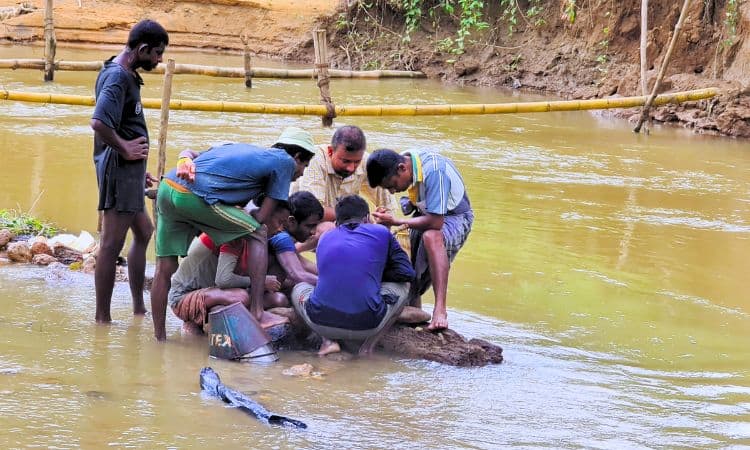Mineral Extraction in Myanmar, Sri Lanka & India: A Deep Dive
Mineral Extraction in Myanmar, Sri Lanka, and India: History, Methods, and Modern Realities
The allure of gemstones has captivated humans for millennia, and nowhere is this more apparent than in the rich mining traditions of Myanmar, Sri Lanka, and India. These South and Southeast Asian nations have long been renowned for their exceptional rubies, sapphires, and other precious stones, shaping global jewelry markets and local cultures alike. In this comprehensive guide, we’ll uncover the fascinating history, extraction practices, and evolving ethical landscape of mineral extraction in these three countries.
Myanmar: The Fabled Land of Rubies
The Mogok Valley – The Heart of Ruby Mining
Myanmar, formerly known as Burma, is synonymous with the world's most coveted rubies. The Mogok Valley, nestled in the country's north, has been a legendary source of high-quality rubies, sapphires, and spinels for over 800 years. Burmese rubies, famed for their vivid 'pigeon blood' red hue, are prized by collectors and jewelers worldwide for their unmatched clarity and color saturation.
- Historical Roots: Ruby mining documentation in Myanmar dates back to the 19th century, though local traditions trace mining as far as the 13th century.
- Colonial Influence: British colonial rule (1886 onwards) saw the establishment of state-controlled gem mines, aiming to monopolize the lucrative ruby trade. The British brought structure and regulation to extraction while exploiting local resources for imperial gain.
- Cultural Significance: In Myanmar, rubies symbolize royalty, power, and spiritual protection. They are often featured in ceremonial regalia and family heirlooms.
Mining Practices and Labor Conditions
The organization of mining in the Mogok region changed drastically under colonialism. The British introduced large-scale extraction methods and enforced state control over the mines, often at the expense of local communities. Laborers faced long hours, harsh conditions, and low wages—a legacy that still impacts the industry today.
- Traditional mining techniques coexist with mechanized methods, though small-scale, family-run pits remain common.
- Labor rights have gradually improved, but challenges such as fair wages and safe working conditions persist, especially in informal sectors.
Sri Lanka: Gem Island and the Sapphire Legacy

sapphire mining in sri lanka in a pit
History and the Influence of Colonial Powers
Known as the "Gem Island", Sri Lanka’s gemstone mining heritage dates back over 2,000 years. The island’s sapphires and rubies have adorned royalty from Persia to Britain. Colonial powers—the Portuguese, Dutch, and British—each left their mark, shaping mining laws and trade networks.
- Ceylon Sapphires: Renowned for their signature cornflower blue color and exceptional clarity, Ceylon sapphires are among the most valuable gems in the world.
- Influence of Colonialism: Colonial rulers imposed extraction quotas and taxation, directing much of the island’s mineral wealth overseas.
Modern Regulation and Ethical Practices
Today, Sri Lanka's gemstone sector is regulated by the National Gem and Jewellery Authority (NGJA), which enforces fair mining practices and sustainable extraction. The NGJA oversees licensing, ensures environmental protection, and promotes worker safety.
- Most mining is done through small-scale, family-run pits using traditional hand-dug methods, preserving both the environment and local livelihoods.
- Strict export controls and transparency measures help curb illegal mining and ensure ethical sourcing.

sapphire mining in sri lanka
India: From Colonial Exploitation to Sustainable Mining
A Storied Gemstone Tradition
India’s relationship with gemstones is as ancient as its civilization. The subcontinent has yielded world-famous diamonds, sapphires, and a spectrum of colored stones. However, the colonial era brought significant challenges to the sector.
- Colonial Impact: British authorities extracted vast mineral wealth from India, often with little regard for environmental or human costs. Local miners frequently endured poor working conditions and minimal compensation.
- Post-Independence Reforms: After gaining independence in 1947, India nationalized its mining sector, prioritizing ethical labor practices and sustainable resource management.
Modern Mineral Extraction and Regulation
India now boasts comprehensive mining regulations designed to protect workers and the environment. The government actively promotes responsible sourcing, transparency, and fair trade within the gemstone sector.
- Strict licensing and environmental impact assessments are mandatory for all mining operations.
- There is increasing emphasis on artisanal mining cooperatives and community-based initiatives, improving livelihoods while reducing exploitation.
Comparative Overview: Myanmar, Sri Lanka, and India
| Country | Key Gemstones | Historical Context | Modern Regulation | Labor & Ethics |
|---|---|---|---|---|
| Myanmar | Rubies, sapphires, spinels | Centuries-old tradition; British state control in 19th century | Partial reforms; ongoing issues in informal sectors | Legacy of harsh colonial practices; gradual improvements |
| Sri Lanka | Sapphires, rubies | Influence of Portuguese, Dutch, British; ancient mining | NGJA enforces strict oversight | Mostly fair-trade, small-scale operations |
| India | Diamonds, sapphires, colored stones | Colonial exploitation; post-1947 nationalization | Comprehensive modern regulation | Focus on ethical labor, sustainability |
Challenges and Opportunities in Modern Gemstone Extraction
Ethical Sourcing and Fair Trade
Consumers are increasingly demanding ethically sourced gemstones. This has prompted governments and industry bodies in Myanmar, Sri Lanka, and India to implement stricter oversight and support international certification schemes.
- Traceability: Programs that trace gemstones from mine to market help eliminate conflict stones and ensure fair compensation for miners.
- Community Development: Revenue from gem mining is being reinvested into education, healthcare, and infrastructure in mining regions.
Environmental Considerations
Traditional mining methods—especially in Sri Lanka—help minimize environmental impact. However, challenges like land degradation, water usage, and waste management persist, particularly where mechanized mining is used.
- Government and NGO partnerships are promoting responsible mining and land reclamation projects.
- Education and training for miners foster long-term stewardship of natural resources.
Actionable Insights for Gemstone Buyers and Industry Professionals
- Seek Certification: When purchasing gemstones from Myanmar, Sri Lanka, or India, look for credible origin and ethical sourcing documentation.
- Support Fair Trade: Choose vendors and brands that prioritize fair wages and community benefits for miners.
- Educate Yourself: Stay informed about the social and environmental impacts of gemstone mining, and advocate for responsible industry practices.
Conclusion: The Future of Mineral Extraction in South and Southeast Asia
Myanmar, Sri Lanka, and India have shaped the global gemstone trade through their unique histories, resources, and cultures. As the industry evolves to meet modern standards of ethics and sustainability, these nations are poised to remain at the heart of the world’s mineral wealth—offering not only spectacular rubies and sapphires but also success stories in cultural preservation, environmental stewardship, and community empowerment.
By understanding the intricate tapestry of tradition and transformation in these gemstone-rich regions, buyers and industry professionals can make informed, responsible choices that honor both the beauty of the stones and the dignity of those who bring them to light.



Comments (0)
Write your review